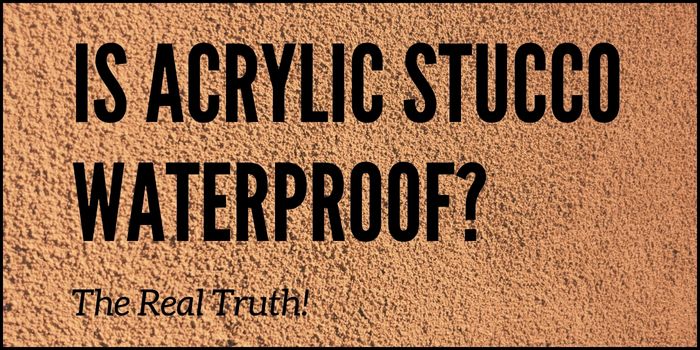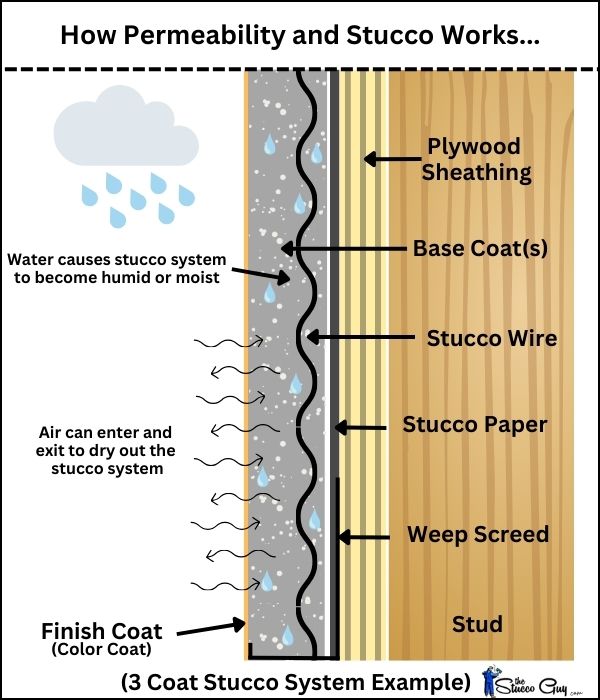
Acrylic stucco has become increasingly popular mainly because of its ability to bridge hairline cracks and provides a vast range of color choices, when compared to a cement based finish. There is a common misunderstanding among people out there though and that has to do with acrylic stucco's ability to manage water.
Let's get the facts straight and delve into the real water-resistant features of acrylic stucco and what it all means.
Is Acrylic Stucco Waterproof?
The short answer is no, acrylic stucco is not waterproof, but it does offer better water resistance compared to traditional cement-based stucco finishes.
The key distinction between the two different types of finishes is in the breathability of the two materials. So that means that while acrylic stucco can repel a significant amount of water, it is still designed to allow for the transmission of water vapor, meaning it has the ability to breathe.
This means that although it can stop a lot of water from seeping into the surface, it also has the ability to absorb and then release moisture, to a certain degree. This effect is essential in order to avoid the accumulation of moisture in walls from getting trapped, which could result in the growth of mold and damage to the more delicate parts of the walls like the sheathing, studs, drywall, etc.

Permeability and Factors Affecting It
Permeability is a term used in different stucco materials, including acrylic stucco and pertains to how well water vapor can move through the material. This permeability rating is signified by a number and the higher the number, the more breathable the material.
A Quick Comparison:
For example, traditional cement based stucco can have a permeability rating of up to 30 to 60 perms, which is very breathable and water vapor flows freely through it. Compare that to acrylic stucco that can have a perm rating of 10 to 30 perms, which is substantially less, allowing for less water vapor to transfer through the finish material.
The permeability rating of acrylic stucco can differ based on many different factors like:
- The Type of Acrylic Product: There are various acrylic stucco options available in today's market, which includes standard acrylic finishes, elastomeric based finishes, and silicone infused finishes, each with its own special characteristics.
The elastomeric and silicone infused options are known for being more water-resistant because of their flexibility and strong bonding, although they may have lower perm ratings compared to some standard acrylic stucco finish options. - Application Method: The permeability rating is also affected by the number of coats applied to the wall and the thickness of each coat, both of which can vary depending on a wide range of factors. Adding more layers of an acrylic finish can enhance water resistance, but at the cost of its overall perm rating.
- Aggregate Size: The size of the aggregate mixed into the acrylic stucco (fine, medium, or coarse) also plays a role in its permeability rating. Finer aggregates typically result in a higher perm rating and coarse aggregates have a lower rating. If we look at Omega's OmegaFlex acrylic stucco products, we can see different perm ratings for these products, based on aggregate size.
Omega's OmegaFlex Perm Ratings:
Aged Finishes: One important thing I also wanted to mention was the fact that the perm rating can change over time, as the acrylic finish gets broken down and faded from the sun and other elements. This is nearly impossible to measure how much, but from my experience, acrylic finishes tend to absorb water more after many years of exposure, which would indicate a higher perm rating.
Let's Use An Example For Clarity:
Imagine you have a greenhouse where you're growing all sorts of plants and inside this greenhouse, you've got a sprinkler system to water the plants.
In order to keep the plants healthy, you need to water them, but you also need to ensure that they're not sitting in too much water for too long. If the air and soil in the greenhouse is always soggy, the plants could start to rot, or mold could start to grow.

The greenhouse needs a way to let excess water escape, kind of like how you'd want a sponge to be able to hold water but also to be able to release that water, when it gets too saturated. This is where the idea of permeability, or the ability to let water vapor pass through, comes into play, similar to the concept we discussed for acrylic stucco finishes.
Let's say the walls of your greenhouse are made of a special material that lets air move in and out but keeps the rain and bugs outside. After you water the plants, the extra moisture in the air needs to go somewhere, or it will get too humid inside. Because the walls are "breathable," they allow the moist air inside to escape, balancing the humidity and keeping the environment inside the greenhouse just right for the plants to thrive.
In the same way, when water enters a stucco assembly on a building, it's important for the stucco to be permeable to some degree, so that any trapped moisture can dry out. If the stucco couldn't let the moisture escape, it would be like our "greenhouse scenario" where the air is too humid, which could lead to deterioration, mold, or other issues for more susceptible materials inside the wall.

